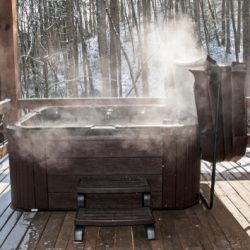Does My Spa Need To Be Winterized?

1. Protection against freezing temperatures
One of the main reasons to winterize a spa is to protect it from freezing temperatures. When water freezes, it expands, which can cause significant damage to the spa’s plumbing, equipment, and shell. By winterizing the spa, you can prevent water from freezing and avoid expensive repairs or replacements.
2. Draining and cleaning
Before winterizing, it is important to drain and clean the spa thoroughly. Remove all debris, clean the filters, and ensure that the spa is free from any lingering chemicals or contaminants. This will help to maintain the longevity of the spa and prevent any issues that may arise during the winter months.
3. Disconnecting and storing equipment
Disconnecting and storing spa equipment is another important step in the winterization process. This includes removing and storing the spa cover, disconnecting and draining the pumps, filters, and heaters, and removing any other detachable components. It is important to follow the manufacturer’s instructions for proper removal and storage to avoid any damage or malfunctions.
4. Adding antifreeze
Using antifreeze is a crucial step in winterizing a spa. This helps to protect the remaining water in the plumbing system from freezing and causing damage. It is important to choose an antifreeze suitable for spas and follow the manufacturer’s instructions for the correct amount to use. Adding antifreeze will provide you with peace of mind during the winter months and ensure the spa is ready for use when spring arrives.
5. Covering and securing the spa
Once the necessary winterization steps have been completed, it is time to cover and secure the spa. A high-quality spa cover should be used to protect the spa from snow, ice, and debris. Make sure the cover is securely fastened to prevent it from blowing off during strong winds. This will help to maintain the spa’s temperature and protect it from the elements.
6. Regular maintenance and inspections
Even after winterizing your spa, it is essential to perform regular maintenance and inspections. This includes checking the cover for any damage or wear, removing any accumulated snow or ice, and ensuring that the spa’s equipment is stored properly. Regular maintenance will help to identify and address any potential issues before they become major problems.
Summary
Wwhile it may not be mandatory to winterize your spa, it is highly recommended to protect it from freezing temperatures and potential damage. Winterizing a spa involves draining and cleaning, disconnecting and storing equipment, adding antifreeze, and covering and securing the spa. Regular maintenance and inspections throughout the winter season are also essential to ensure the spa’s proper functioning. By taking the necessary steps to winterize your spa, you can enjoy a worry-free winter and preserve the longevity of your spa for years to come.
Need a Hot Tub Store in Lubbock, TX?
Family owned and operated since 1959, Alcoe located in Lubbock, TX has been providing five decades of superior experience and knowledge which makes us uniquely qualified to understand and fulfill the expectations of each of our clients. We specialize in the sales, install and service of spas/hot tubs, swim spas, sun-rooms, saunas, infra-red grills, outdoor fire pits and MORE! Round up your swimsuit, towel and goggles, then come experience swimming and relaxing in an Alcoe swim spa first hand. Contact us today to learn more about what we can do for you!
Categorised in: Spas
